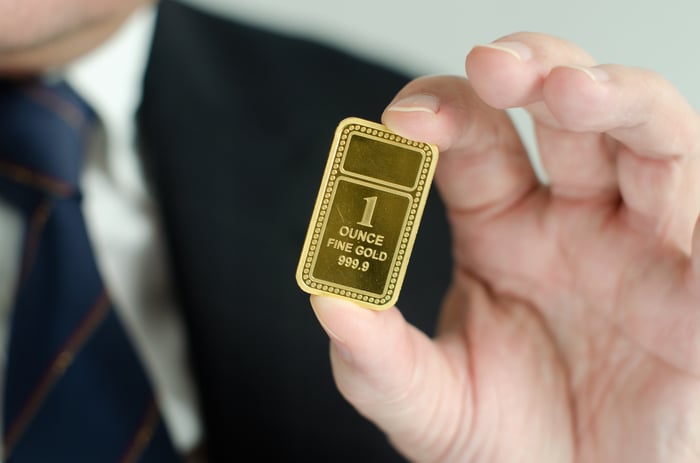Gold and silver are commodities subject to often severe and swift price swings. Generally speaking that means precious metals miners have volatile top- and bottom-lines. But Franco-Nevada Corporation (FNV -1.30%) isn't a miner, it's a streaming company -- and while its revenues and earnings will move around with the price of gold and silver, you wouldn't believe the size of Franco-Nevada's dividend streak. In fact, most miners can only envy the record.
Streaming 101
The first thing to understand about Franco-Nevada is that it doesn't get its hands dirty running mines. Instead it provides capital up front to miners in exchange for the right to buy gold and silver, and other commodities, in the future at reduced rates. This is called streaming. It also owns royalty interests, which are similar in nature.

Image source: Getty Images
Franco-Nevada likes this business because it contractually locks in low prices. Miners like these deals because it gives them access to cash when other options, like banks and capital markets, might not be desirable sources of capital. What's important for investors to understand is that it is a very different way to get exposure to precious metals.
To put that into perspective, Franco-Nevada has increased its dividend every year for 10 consecutive years, including 2017. The company went public in 2007, so a little simple math will tell you that it has upped the disbursement every year since. That, for reference, is a period that includes a deep commodity downturn that led to dividend cuts throughout the mining industry.
For reference, industry giant Barrick Gold (GOLD -2.74%) cut its dividend 75% in 2013 and another 60% in 2015, taking the quarterly payment from $0.20 per share to just $0.02. Over that time frame Franco-Nevada's dividend increased roughly 15%. That's a big difference!
How's Franco-Nevada do it?
What's different about Franco-Nevada's business is the built-in low costs of the streaming model. That affords the company wide margins throughout essentially the entire cycle. A quick look at the commodity upturn that started in early 2016 is all you need to understand this dynamic.
Take a look at the chart below. Barrick's EBITDA margin starts in negative territory and swings higher as gold and silver prices recovered. But Franco-Nevada's EBITDA margin was high even before the commodity upswing began, and it remained fairly consistent as gold and silver prices moved higher. It's that consistency that allows Franco-Nevada to keep paying and raising dividends even when miners are struggling.
FNV EBITDA Margin (TTM) data by YCharts
But there's more to this story that you need to understand.
Opportunity when you least expect it
Since Franco-Nevada provides capital to miners, industry downturns are actually good for its business. That's because it's generally difficult for miners to access capital when commodity markets are struggling.
For example, in 2015 Franco-Nevada was able to ink a $610 million streaming deal with Teck Resources (TECK -0.29%). At that point in time Teck was struggling with a heavy debt burden and needed cash to shore up its balance sheet and fund investment commitments it had made. Commodity markets were in the dumps, severely limiting its options. For its cash Franco-Nevada got the right to buy silver from the Antamina mine at just 5% of the spot price. Note that this deal got signed right before the commodity upturn began in 2016.
With wide margins and a business that benefits from commodity downturns, it's no surprise that Franco-Nevada has an enviable dividend track record. And while the yield is only around 1.1%, a decade of dividend growth speaks volumes about the strength and consistency of the company's business model. If you are looking to invest in precious metals, Franco-Nevada is one name that you should put high up on your wish list.






